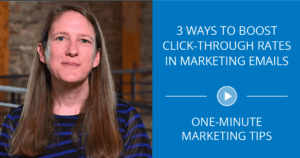How a conversational marketing strategy will help you stand out
Nothing beats a good conversation. It’s a relationship builder. It helps you better understand the other person. And, when the conversation is truly great, it can be memorable, something you think about often.
Conversations have become so important in our lives, they’ve even made their way into marketing strategy. Conversational marketing is making a buzz. So what is it? Simply put, conversational marketing is about engaging with customers one-on-one to stand out from the competition and humanize your brand. It’s about making your customers feel seen, heard and understood through a personalized approach—having two-way conversationswith them rather than pushing information and content at them.
If you’re trying to get a better understanding of what this looks like and how to create a conversational marketing strategy, read on for ideas.
Why conversational marketing is important
HubSpot Co-Founder Dharmesh Shah says, “The key is to remember that conversational marketing should be designed around the needs of the customer—not the needs of the business.” That means conversations need to happen on customers’ time. If a customer wants help before they start work in the morning or late at night, they expect to get it.
The pandemic has also heightened two reasons why brands need to implement conversational marketing: longer sales cycles and customers’ need for empathy. More than two-thirds of B2B buyers say the length of their purchase cycles has increased compared to a year ago. While your customers take longer to make decisions, you’ll need to stay top of mind—conversations can help. Meanwhile, customers are expecting an individualized, more human buying experience, much like conversational marketing can deliver.
In fact, trust is the biggest key to building sales. When you engage one-on-one with a potential buyer, they won’t feel like “just another customer.” Having conversations to understand their needs, wants and challenges makes them feel like you get them. Conversational marketing lets you speed up your sales cycle through empathy that builds trust.
What conversational marketing can do for your business
Conversations make your marketing more personal. When asked, almost 29% of marketers said customer personalization is the next big trend in marketing (PDF). Having one-on-one conversations lets you hear, in your customers’ own words, what their wants and needs are—which allows you to tailor their experience.
This also opens up opportunities to cross-sell and up-sell. By knowing who they’re talking to on a more personal level, sales reps can recognize more quickly when other products are a good fit for your customers.
In addition, conversational marketing lets you meet rising expectations for fast responses and therefore, keep more leads. Many customers will choose to go somewhere else rather than wait—51% of people say they would stop using your brand’s conversation channel if it were slow to respond.
How to implement conversational marketing
When it comes to creating your conversational marketing strategy, you have a plethora of options. Consider the following:
- Use real people as much as possible. Humans are (still) more compelling than chatbots. Malte Scholz, CEO and co-founder of Airfocus, sums it up well when he says, “The best tip for implementing a conversational marketing strategy is to get rid of chatbots and employ a human touch.”
- If you use chatbots, (perhaps you don’t have enough staff to be on 24/7) make them be as personalized as possible. You never want a customer to feel like they’re talking to a robot (even if they are).
- Gather context with a CRM. Storing info about each customer interaction—the questions they ask, their name, demographics and when they convert (or drop-off), gives you the information to optimize their experience. The more you know about your customer and the more you can demonstrate that in your conversations, the more helpful you’ll be.
- Use the channel your customers prefer. Around 79% of consumers are willing to use messaging apps to get customer service and over 85% prefer a one-on-one conversation over forms. Where do your customers fall? Is a phone call their number one preference? Maybe email is most convenient—or a live chat with a human. Once you know their favorite channel, you can meet them where they’re at for a more personalized experience.
- Respond in a timely manner—regardless of your channel(s). This may also mean reconsidering your use of forms. It takes an average of 4.3 days for sales reps to schedule a meeting after a prospect submits a form. During that time, 38% of qualified leads have chosen another vendor. Make your customers happy by responding quickly.
- Have in-person or video interactions. “No matter what’s happening online, a face-to-face dialogue elevates the entire communication,” says Nicole Bojic, SVP of strategy at InVision Communications. While technology is leveraged to take the conversation to the next level, nothing can replace talking in-person. Or, now with COVID-19, talking over a video chat.
At the end of the day, conversational marketing boils down to this: a personalized, one-on-one customer experience. With a solid understanding of what is conversational marketing and how to implement that in your buyer’s journey, you can help people feel more connected to your brand over any other.




